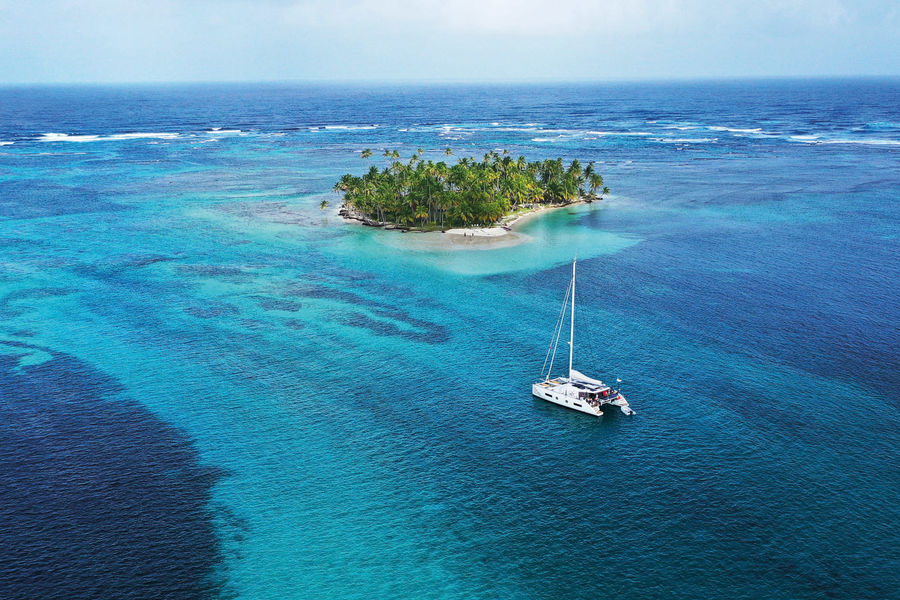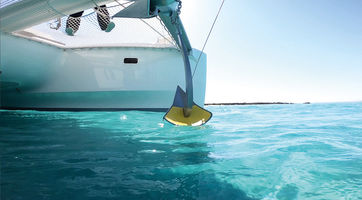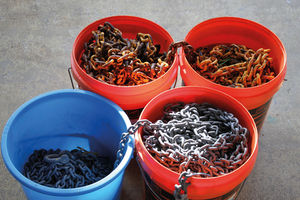
Issue #: SP16
Published: August / September 2021
- Price per issue - digital : 7.90€Digital magazine
- Price per issue - print : 9.90€Print magazine
- Access to Multihulls World digital archives Digital archives
Jonathan and his wife Josephine bought their Lightwave 38 new, and sail out of their homeport of Sydney, Australia. The couple regularly sail to the tropical north, but with places like the Whitsundays becoming increasingly popular, they decided to move their annual cruises south. Tasmania enjoys at least one Storm Warning a month through the summer, and many more in winter. The couple’s ground tackle has been honed to meet the demands of anything the Southern Ocean and Roaring Forties can throw at them. This article is a description of part of their ground tackle developments.
Multihulls, catamarans in particular, have been using bridles for decades. The major reasons to use a bridle were to reduce veering and to take the load off the windlass. Sadly, most multihull bridles miss one of the major advantages of introducing rope between chain and yacht because the common multihull bridle lacks elasticity. Multihull bridles tend to be too short and too large in diameter and if you want any snubbing effect, you need elasticity. Elasticity is simply best achieved with thin, long, commonly, nylon rope.

When blue water cruising, multihulls spend up to 90% of their time at anchor – reason enough to pay close attention to all the elements that make up the ground tackle.
ENSURE YOU HAVE SWINGING ROOM!
Multihulls at anchor are subject to three primary effects, the windage of the vessel, yawing or veering (movement of side to side of the vessel caused by vessel characteristics or a wind that gusts from different directions) and horsing, up down see-sawing motion caused by waves, swell or chop. The common perception is that the windage of a vessel, in particular a catamaran, is a major concern. Indirectly this is true but directly the tension caused by the windage in a steady wind is well within the holding capacity of a correctly sized rode and anchor, properly set in a good holding seabed. It’s the movement of the multihull (or any other vessel) or bad luck that might cause an anchor to drag - not a steady tension caused by windage. Most modern 35 lb/15kg anchors will hold a steady pull of a couple of tons - a tension unlikely to be developed by a catamaran in any imaginable wind sized for such an anchor! It is snatch loads resulting from movement and lateral loads that are the killer - not ‘in line’ windage.
 |
 |
We often assume the quality of the ground tackle based on the anchor – seen here, a Spade. But the chain and the bridle are just as important!
Our 75m (250’) of 6mm chain, in the near 2 pails, replaced the original 50m (160’) of 8mm chain, in the rear 2 orange pails, saving both space and weight - but sacrificing catenary.
ANCHOR CHAIN CATENARY
The reason that veering can be the most catastrophic is simply that the multihull can ‘sail’ at anchor and any speed it develops can produce tensions in the rode well beyond windage. During testing at short scope, we have measure snatch loads of ‘only’ 650kg (1,450 lbs) - they are frightening, but the anchor has held. These tensions developed by veering can be increased with additional tensions from chop and swell, caused by the wind or a passing motor boat. The anchor rode has similarities to the bungee cord. A common chain develops a catenary when deployed, that ‘sag’ in the chain, and as the wind develops that sag is removed (in part) and the straightening of the sag is the chain absorbing some kinetic energy. If the wind eases that sag returns as the yacht is pulled forward. Unfortunately, catenary has a finite limit and at the point when the chain ...
What readers think
Post a comment
No comments to show.